
Head Surgery Page Menu: 1 2 3 4 5 6 7 8 9 10 11 12 13 14 Next>>
Head Surgery During the Golden Age of Piracy, Page 6
Non-Trepanning Treatments
"A bone depressed from it natural position rarely requires trepanning; and those which are most pressed and broken require trepanning the least; neither does an indentation (hedra) without fracture and contusion require trepanning; nor does a notch, provided it is large and wide; for a notch and a hedra are the same." (Hippocrates, On Injuries of the Head, Translated and Edited by Francis Adams, p. 452)
There were a variety of treatments for head wounds that didn't involve trepanning or drilling holes in the skull. Trepanning was viewed by many surgeons as a treatment of last resort for a head wound. As noted previously, when a fracture didn't go completely through the skull trepanning wasn't usually considered unless the symptoms suggested differently. Among the non-trepanning procedures used were humor-based therapies, removing splinters from the skull, rasping the fractured bone and raising a depressed skull.
Non-Trepanning Treatments: Humor-Based Therapies
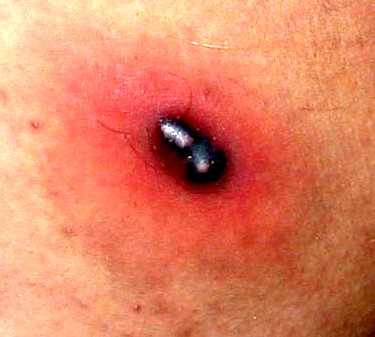
Photo: Sven Teschke - An Abscess
Sea surgeon John Atkins is the primary source among the surgeons under study for humor-based therapies to treat head wounds during this period in history. While John Moyle suggested bloodletting as a pre-operative treatment to relieve the patient, Atkins thought that bleeding and other humor-based treatments alone could cure the patient with a head wound.
One of his suggested humoral-based treatments involved removing fluid humors from the skull. He explains that "The Nose, Mouth, and Ears, that give the Signs of a Fracture, point out also the best Way we have of relieving the Symptoms; how often have we seen Impostumes [abscesses] and Hæmmorhages, in Relief of this principal Part the Brain; and were Warmth cherished to the Ears and Head, the Clypeum [skull] kept whole."1 Pus collects in abscesses and is eventually ejected from the body. Both pus and blood were considered undesirable humors and their leaking from wounds was considered a positive sign. Atkins is suggesting that leaking pus and hemorrhages that allow blood to flow from the body cured skull fractures. These humor-based therapies combined with keeping the head warm allowed the surgeon to avoid trepanning a patient according to him
Based on this concept, Atkins goes on to recite a number of other procedures the surgeon could perform to serve the same purpose.
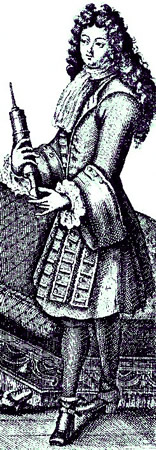
Artist: Nicolas Arnoult
Surgeon With Enema Syringe
Errhines [medicines that increase mucus and cause sneezing] used to force from the Brain and sinus frontalist, where Depurations [impurities] are lodged; would with Shaving, Spirituous Embrocations [lotions rubbed on the skull], a soluble Diet [one that is easily digested], Issues, Setons, &c. work with more Success for the Patient, than Trepanning Treatment: There is nothing we can do of this kind, but will be dependent in respect to the Brain, a favourable Situation with the Circulation, to answer the Purpose, when they are recoverable.2
So he felt that other humor-focused treatments were aligned with the blood and helped the brain when it was wounded. Atkins also suggested a humoral treatment for situations where blood was trapped or leaking in the space between the inside of the skull and the meninges. (Trapped blood was one of the reasons many surgeons recommended trepanning.)
Revulsions will contribute more to the Cure than the Operation of the Trepan... I have known both [skull] Fractures and Concussions, especially the latter, to have been relieved and recovered without trepanning, and that by large [amounts of] Bleeding, Enema’s, Purges, Fontanels, and nervous Administrations; which either derive the extravasated [leaking] Blood from the Brain, carrying it off by the Emunctories [nasal discharge] and Bowels, much more likely so to do when both Cold and Air are excluded, which all [physicians and surgeons] allow to be injurious to the Membranes and Brain, or [the surgeon can] fix an Abscess on some less principal Part.3
The concept of 'revulsion' is a remedy whereby the surgeon did things that would cause the body to expel
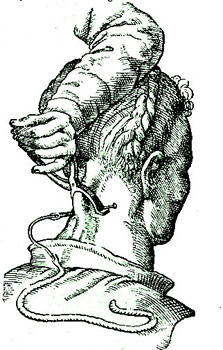
Artist: Marcus Severinus
Seton Needle Insertion in Neck, From Opera
quae extant omnia, by William Fabry (1682)
various bodily fluids (or 'humors') with the idea that this would offset forming or collecting of unwanted humors elsewhere in the body. In the above quote, Atkins gives a laundry list of humoral remedies that were used during this time. By 'bleeding' he means opening a vein (usually in the arm) to let the excess blood humors out or even divert them from gathering in the skull. 'Purges' refer to emetics (medicines that cause vomiting) and/or laxatives. One 'purged up' while the other 'purged down'. His last suggestion to 'fix an Abscess on some less principal part' meant to apply medicines such as suppuratives or devices such as fontanels that intentionally infected the body where they were applied. The infection caused the formation and draining of 'laudable pus' from that site. "This treatment [fontanels] was an extension of the practice of deliberately keeping wounds open for the exit of 'laudable pus', based on the theory first derived from Galen and which lasted until [Joseph] Lister."4
Atkins provides an example of his humoral treatments in a 1703 case study involving a sailor who received a large wound with a fracture in the skull during battle. "He was blooded every Day for a Week, sometimes in the Jugular, and sometimes in the Arm, or Foot; and had a Fontanel cut inter Scapulas [between the shoulder blades]. Without any other Means, the Wound in a Month, was contracted to a small Compass [size], and the Delirium [wore] off"5. The head wound eventually healed although Atkins admits that the man "continued troubled with a Giddiness, Pain in the Head, and Epileptick Fits; (the latter, perhaps, rather imputable to the Fright, than Fracture.)"6
So even Atkins hints that humoral procedures may not have been entirely effective. As with some of the other treatments discussed previously, this is notable in that only one author recommends it. So it may not have been very widely practised.
1,2 John Atkins, The Navy Surgeon, 1742, p. 82; 3 Atkins, p. 83-4; 4 Elizabeth Bennion, Antique Medical Instruments, p. 69; 5,6 Atkins, p. 89
Non-Trepanning Treatments: Removing Foreign Objects From the Skull
A simple operation sometimes performed on a patient with a head wound was the removal of foreign objects from wound of the skull.
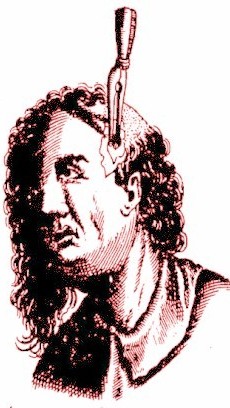
Removing Splinters with Forceps, From l'Arcenal
d' Chirurgerie, By Johannes
Scultetus (1674)
If the skull had been fractured through both the inner and outer tables, the underlying meninges and brain could be pricked by the splinters of bone causing the patient pain, problems with loss of function such as were described in the section on symptoms and delayed healing.
Richard Wiseman explains that "we meet with many ...Wounds [of the Brain]: in them we hasten our way to the extraction of extraneous Bodies, by cutting off the shattered Hairy skin first, then pulling out whatever was carried within the Cranium."1 In a case involving a soldier with a variety of wounds to his skull, Wiseman notes how after cleaning the wound they found "pieces of Scull sticking on it: some of them were of the first Table, others of both Tables. ...We freed the Scalp of those Bones"2.
In his recommendations for 'the cure of wounds of the head', sea surgeon John Woodall notes that once the hair is shaved off, "if any loose bones be [in the wound], take them out"3.
John Moyle explains the problem with splinters. He advises the surgeon to further open the wound by cutting to enable him to "come at [the wound] to get out the shivers [slivers] of bones... For in this the dura mater is wounded, or at least bruised with the splinters of bones, so that it bleeds (but then there is vent for it [through the existing wound]; and there needs not Terebration [trepanning])"4. His last comment suggests that since the wound was already releasing blood from under the skull, there was no reason to apply the trepan to let trapped blood escape.
French surgeon Ambroise Paré warns the surgeon to take "speciall care, lest that in pulling and taking out of these scales [thin, flat pieces of bone] and splinters, we hurt the membranes. These scales are sometimes very rough and prickly, so that they cannot touch the Meninges without offence, but somewhiles the business is so intricate, that they cannot be taken out unless by enlarging the fracture."5 When there is sufficient room, Paré recommends using 'mullets' or cutting forceps to enlarge the sides of the fracture, noting that "the operation performed by these mullets is far more speedy and safe, than that with the Trepan; and in the performance of every operation, the chief commendation is given to safeness and celerity [speed]."6

An Elevator/Levatory, From The Workes of
that Famous Chirurgion Ambrose Parey. p. 270 (1649)
Various tools could be used to remove the pieces of bone. Moyle explains in one of his case studies that when two pieces of "Bone [were] beaten in, which lacerated the Crassior Tunicle [thick membrane]. These were instantly extracted with Forceps"7.
Forceps would seem to have been the most obvious tool for removing splinters and other foreign objects. However, they are not the most mentioned device for that purpose. Ambroise Paré advises that bone splinters be removed "with Levatories [elevators] made and neatly fashioned for that purpose, such as these, which are here exprest [see image above]."8 Sea surgeon John Woodall agrees advising the use of "a Levatorie instrument [elevator] will excuse the use of a Trapan, and take away the spills [splinters] and fragments which are upon the Membrane"9. How this was done isn't detailed by these authors, but it appears that the elevator would be used pry under the sliver and flip it up and out.
In another case where a soldier had been shot in the head and Wiseman had bandaged it to stop the bleeding, "we opened the Wound again, endeavoring to get out the Bullet: but it not yielding thereto, we set on a Trepan close
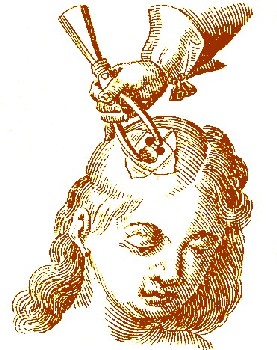
Using Forceps on the Cranium, From Armamentarium
Chirurgicum Bipartitum,
by Johannes Scultetus (1666)
by it in a depending part, and gave vent to a quantity of blood: then passing in a Levator we raised up the Bullet, and pull’d out the depressed Bones, with which there came away some blood and a little of the Brain."10 So sometimes trepanning was still required to allow access to the head from another point when removing foreign objects.
Any foreign object in a skull wound had to be removed for the patient to heal. In another case, Moyle discusses the need to remove dirt from a patient's skull wound, "who by a fall from his Horse, had his Head sorely Wounded and Lacerated against the Stones; the Bone was bare for a large Space, the Calva [scalp] and Pericranium being torn off, and the Wound full of Gravel and Dirt."11 When he met with the patient, Moyle used a foment of red wine to wash the wound with hot stupes, noting that "it was half an Hour e’re I could get out all the Dirt."12 While he doesn't say what tool he used (other than the wash of wine and the cloth stupes), it would likely have been a pair of fine forceps.
Richard Wiseman discusses another element of splinter removal when it is the only operation performed on a patient with a head wound. He explained that after a wound in the skull is cleaned and the splinters are removed, "we then dress up the Brain and Membranes with a Sindon [medicated rag] of Silk or soft Linen of a bigness proportionable to the Wound, dipping it in a warm Digestive [medicine for promoting the growth of healthy flesh], such as is proper for the wounded Membranes."13 This type of dressing is to allow the skin to heal and would only be appropriate when the patient was not showing symptoms of a more serious head wound.
1 Richard Wiseman, Of Wounds, Severall Chirurgicall Treatises, 1676, p. 401; 2 Wiseman, p. 399-400; 3 John Moyle, The Sea Chirurgeon, 1693, p. 107; 4 John Woodall, the surgions mate, 1617, p. 135; 5,6 Ambroise Paré, The Workes of that Famous Chirurgion Ambrose Parey, 1649, p.270; 7 Moyle, Memoirs: Of many Extraordinary Cures, 1708, p. 2; 8 Paré, p. 269; 9 John Woodall, the surgions mate, 1617, p. 135; 10 Wiseman, p. 401; 11,12 Moyle, Memoirs, p. 26; 13 Wiseman, p. 402

